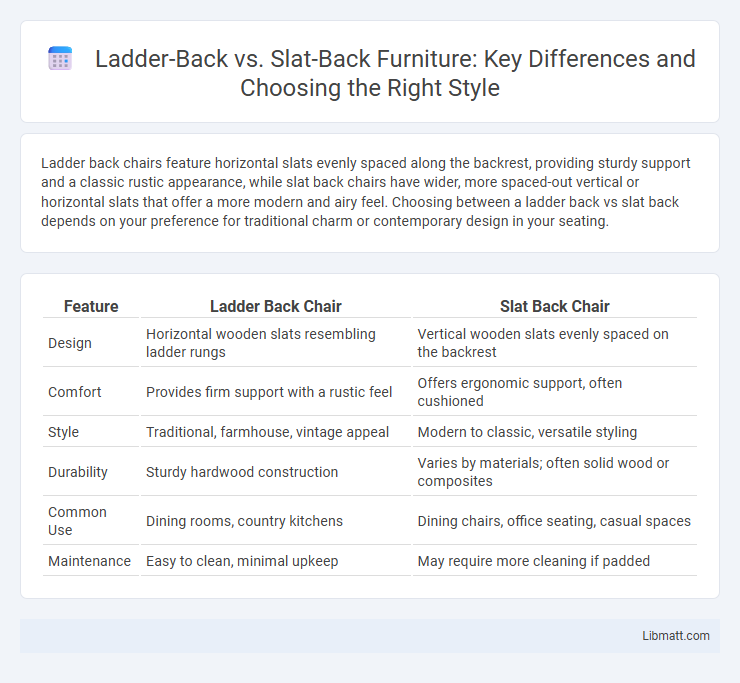Ladder back chairs feature horizontal slats evenly spaced along the backrest, providing sturdy support and a classic rustic appearance, while slat back chairs have wider, more spaced-out vertical or horizontal slats that offer a more modern and airy feel. Choosing between a ladder back vs slat back depends on your preference for traditional charm or contemporary design in your seating.
Table of Comparison
| Feature | Ladder Back Chair | Slat Back Chair |
|---|---|---|
| Design | Horizontal wooden slats resembling ladder rungs | Vertical wooden slats evenly spaced on the backrest |
| Comfort | Provides firm support with a rustic feel | Offers ergonomic support, often cushioned |
| Style | Traditional, farmhouse, vintage appeal | Modern to classic, versatile styling |
| Durability | Sturdy hardwood construction | Varies by materials; often solid wood or composites |
| Common Use | Dining rooms, country kitchens | Dining chairs, office seating, casual spaces |
| Maintenance | Easy to clean, minimal upkeep | May require more cleaning if padded |
Introduction to Ladder Back and Slat Back Chairs
Ladder back chairs feature horizontal slats running across the backrest, providing sturdy support and a classic rustic aesthetic often found in farmhouse and country-style decor. Slat back chairs display vertically oriented slats or narrow wooden strips aligned side-by-side, delivering a visually lighter, contemporary design ideal for modern dining spaces. Both designs emphasize durability and comfort, with ladder back chairs offering a more robust, traditional appeal and slat back chairs providing sleek flexibility in interior design.
Historical Background and Origins
Ladder back chairs trace their origins to 17th-century Europe, characterized by horizontal slats connecting the chair's two back posts, offering sturdy support and a simple design suited for rural homes. Slat back chairs, evolving slightly later, feature evenly spaced vertical or horizontal slats, reflecting a more decorative approach seen in American Colonial furniture. Understanding these historical roots can help you appreciate the distinct craftsmanship and cultural influences behind each style.
Design Characteristics of Ladder Back Chairs
Ladder back chairs feature horizontal slats evenly spaced along the backrest, creating a sturdy, classic design known for durability and support. The wide, flat slats often contribute to a rustic or farmhouse aesthetic, providing a comfortable leaning surface for your back. These design characteristics distinguish ladder back chairs from slat back variants, which typically have thinner, more closely spaced vertical slats for a modern, sleek look.
Design Characteristics of Slat Back Chairs
Slat back chairs feature a series of evenly spaced vertical or horizontal wooden slats forming the backrest, providing both support and ventilation. The design emphasizes simplicity and durability, often showcasing clean lines and a more open, airy appearance compared to ladder back chairs. These characteristics make slat back chairs ideal for modern or rustic settings seeking functional, visually light seating options.
Material Choices and Construction Methods
Ladder back chairs typically feature horizontal wooden slats attached to vertical uprights, often crafted from hardwoods like oak or maple for durability and classic aesthetics, with joints reinforced using mortise and tenon construction methods. Slat back chairs also rely on vertical or slightly angled slats but may incorporate a wider variety of materials such as metal or composite woods, combined with dowel or screw-based assembly techniques for increased versatility and modern appeal. Both styles emphasize sturdy frameworks, but ladder backs lean towards traditional joinery, while slat backs allow more contemporary material innovations and assembly options.
Comfort and Ergonomics Comparison
Ladder back chairs provide firm lumbar support with horizontal slats that conform to the natural curve of the spine, enhancing posture and reducing back strain. Slat back chairs feature vertical or slightly angled slats that allow for better airflow and flexible backrest movement, improving overall seating comfort during prolonged use. Ergonomically, ladder back designs typically offer more structured support, while slat back chairs emphasize adaptability and breathability for diverse seating preferences.
Aesthetic Appeal and Interior Applications
Ladder back chairs feature horizontal slats that create a classic, rustic aesthetic ideal for traditional or farmhouse interiors, adding warmth and texture to your space. Slat back designs, with their vertical or varied slat arrangements, offer a sleek, modern appearance that complements contemporary and minimalist decor styles. Your choice between ladder back and slat back chairs can enhance the overall visual harmony and stylistic theme of your interior design.
Durability and Maintenance Considerations
Ladder back chairs, with their thicker horizontal rails, often provide enhanced durability compared to slat back designs, which feature thinner, more spaced-out slats that may require more frequent repairs. Maintenance for ladder backs is generally simpler, as their solid construction withstands wear and tear better, reducing the need for regular tightening or replacement of individual slats. Ensuring your chair choice aligns with your durability and upkeep expectations will help extend the lifespan of your seating furniture.
Cost and Accessibility Differences
Ladder back chairs typically offer a lower cost due to simpler construction and widespread availability in budget-friendly furniture stores. Slat back chairs, often featuring more intricate designs and higher-quality materials, tend to be priced higher and are commonly found in specialty or upscale retailers. Accessibility varies as ladder back styles are more prevalent in rustic or casual settings, while slat back options are preferred for formal dining environments, influencing where they can be easily purchased.
Which Chair Style to Choose?
Choosing between ladder back and slat back chairs depends on your style preference and comfort needs. Ladder back chairs feature horizontal rails that offer classic support and a traditional look, while slat back chairs provide a more modern, open design with vertical or slightly curved slats. Your choice should reflect the room's aesthetic and how much lumbar support you require for daily use.
Ladder back vs slat back Infographic

 libmatt.com
libmatt.com